If you have a sweet tooth and a fondness for traditional Indian sweets, then the rasgulla must not have escaped your scrutiny. This Bengali sweet delicacy is a favourite with almost anyone.
These round orbs of cottage cheese that are simmered in a sugar syrup offer a sensationally sweet taste that is unmatched by other sweets.
Although they are not difficult to prepare, there are some tips that need to be borne in mind before you prepare them like the quality of the milk used. Traditionally in this recipe full cream milk is used as that result in super smooth rasgullas. However, I have tried this with the double toned milk and the result was equally good. Another thing to bear in mind is the quality of sugar. That should be free of impurities.
The original recipe for this super easy pressure cooker rasgulla recipe was shared by my friend Sheetal Ashpalia who is an awesome home chef. I have tweaked it a little to add a few ingredients.
This is my take on this classic sweet.
RASGULLA
INGREDIENTS
1 litre full cream milk (as mentioned above this will give you a creamier chena/cottage cheese but, I used double toned milk and was quite satisfied with the result)
1 tbsp lime juice + 2 drops
3-4 pods of green cardamom (elaichi), broken open or ½ tsp cardamom powder
1 tsp rose water/essence (i recommend using this since it adds a lovely fragrance that complements the cardamom)
A few strands of saffron (optional)
1 ½ cup sugar
3 1/2 cups water
Note – some recipes substitute the lime juice with vinegar. I do not recommend that. Traditionally sour butter milk is used to obtain the cottage cheese but lime juice yields faster result. Citric acid does not allow the chena to go hard which quite frequently is the case if you use vinegar which contains acetic acid.
The saffron imparts a yellowish cream colour to the dish. So, if you want white rasgullas then I recommend not using saffron at all. However, saffron does impart a delectable aroma to the dish.

The first picture is of saffron infused rasgulla. The second one is sans the saffron infusion. The saffron is added only as a garnish at the end, before serving.
Some recipes also recommend adding 1 tsp of maida (refined all purpose flour) to the chena while kneading. I do not recommend that.
The most important thing to note while making rasgulla is to treat the milk fairly. Using full fat milk oir toned milk will make a difference to the rasgulla’s texture. Similarly the rasgullas will turn out differently based on whether you are using homogenized (packet milk), tetra packed milk or non-homogenized (the kind we get un-packaged from the milkman). If you are using packaged milk then make sure to bring it to boiling point and then incorporate the lime juice. Turn off heat the minute you use the lime juice and stir to let the milk curdle. Once you see it curdling, immediately add ice cold water to it. That will stop the further cooking of the chena and you will get a softer chena.
METHOD
- Making the sugar syrup – in a pressure cooker add 1 ¼ cup sugar, 3 1/2 cups water, 3 pods of cardamom, 2 drops of lime juice (this stops over crystallization of sugar) and also a few strands of saffron (if you want to use it). Cover the lid and give it one whistle on medium heat. This is your sugar syrup done. If you are doing this sans the cooker then let the syrup simmer on low heat for about 10 minutes.
- Making the chena/cottage cheese – heat the milk in a vessel and bring it to a bubbling boil. Reduce heat or switch off completely and add the lime juice, stirring continuously. After about 1 minute you will see the milk start to separate. The top portion will be the white cottage cheese and the bottom shall be the whey (light greenish in colour). Once the separation happens completely, switch off the heat and strain the chena in a muslin cloth (yes, not a sieve. It must be a cloth). Alternatively for full fat milk you can switch off heat after the milk starts bubbling and add 1/2 cup water. Wait for 5 minutes so the temperature of the milk comes down a bit and then add the curdling agent. This will give you a soft and smooth chena.
- Immediately after straining put the chena in a bowl full of cold water. Our attempt is to remove any traces of both the whey and the citric acid. So, wash the chena in cold water and strain again in the same cloth. This dunking in cold water is vital also to prevent the overcooking of the chena. If it is overcooked, it will yield hard rasgullas.
- Squeeze the cloth really tight till no moisture remains. You can also choose to hang up the cloth for about half hour and let the liquid drip. Post half hour squeeze it to remove any remaining water. The important thing is to remove the water completely. Once done you will get a crumbly consistency white coloured residue. This is your chena or cottage cheese.
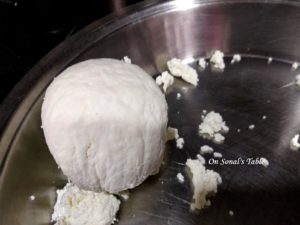

- Knead the chena with your hands for a good ten minutes till it becomes soft, smooth and creamy. The kneading must involve your palms and not fingers. Apply pressure on the chena with your palms so that no grains remain and the residue turns pliable. This could take about 10-12 minutes. If your chena does not turn soft and fluffy after 10 minutes also then I recommend chucking that and starting another batch. It needs to be really soft to get soft rasgullas.
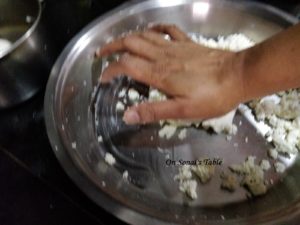
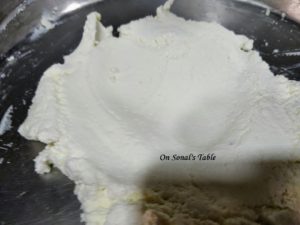
- Once you have your dough done, form it into small balls (1.5 cms in diameter) by rolling it between the palms of your hands.
- These are gullas sans the ras. Don’t worry about the small size because they will double in size in the syrup.
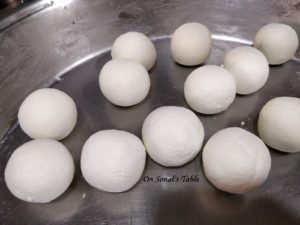
- Drop the balls into the sugar syrup gently and put the lid of the cooker back on. Give 3 whistles on medium heat.alternatively you could also give 1 whistle on low heat. Switch off the gas after that and let the pressure release from the cooker on its own. Once the lid opens, switch on heat again on low and let the rasgullas simmer on that for 5-7 minutes. Close the lid after switching off gas and leave them in the cooker till they cool. If you want to do this in an open pan (without pressure cooking) then it could take about 15 minutes on low heat for the gullas to absorb the syrup. Simply heat your sugar syrup and bring it to a bubble before you drop the gullas in.
-
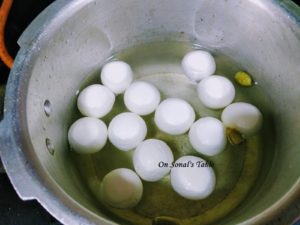
- Once done, stir in the rose water. You can also choose to garnish it with a few strands of saffron.
- Let the rasgullas cool completely before you refrigerate them. serve cold.
 Sonal Singh On Sonal's Table
Sonal Singh On Sonal's Table

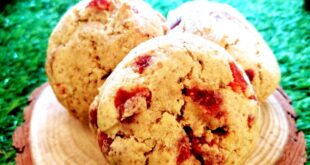
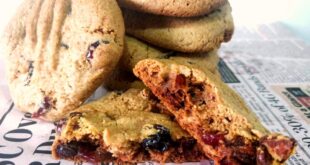
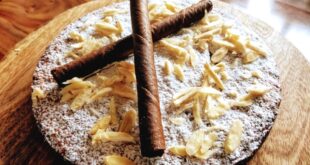
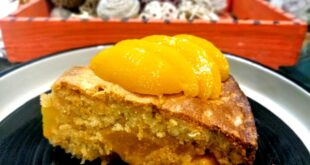
Ah, Sonal Singh, these look doubly enticing compared to mine! What a wonderful take on this classic recipe, I absolutely love them!
🙂 Thank you